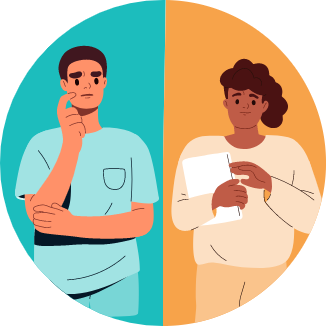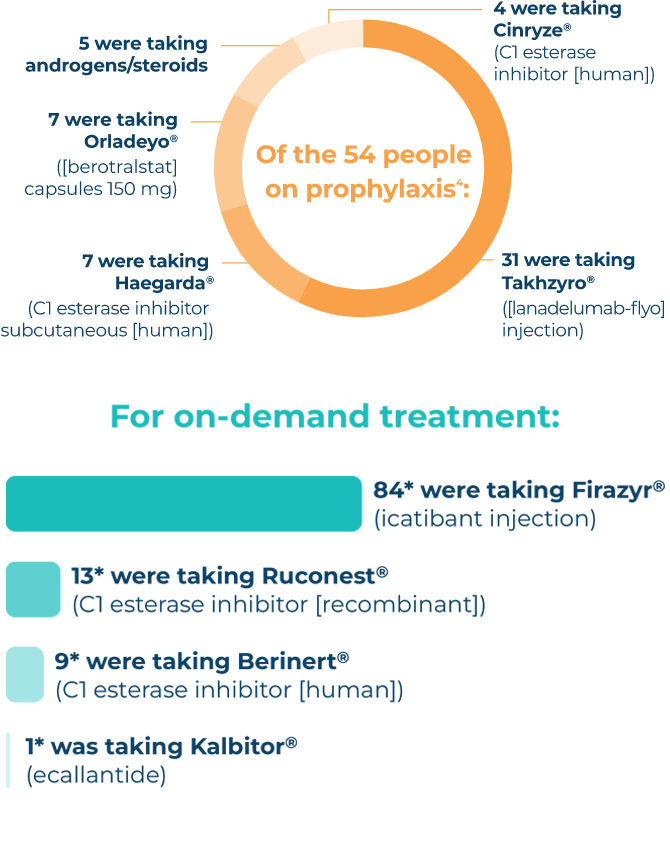For the best experience, the HAE Attack Journey requires your device to be sideways. Please turn your device to continue.


Answer 5 questions to see if your experience is similar to those in the HAE Attack Journey Survey.
THE HAE ATTACK JOURNEY SURVEYED PEOPLE LIVING WITH HAE WITH THE GOAL OF UNDERSTANDING:


There are times when people living with HAE delay on-demand treatment or decide not to treat an HAE attack. The HAE Attack Journey Survey has revealed that many people living with HAE find it difficult to carry their on-demand treatment and struggle with the anxiety of whether to treat when they recognize an attack. Lack of privacy required to administer medication, preferring to treat at home, and fear of injection or pain of medication are 3 of the most common reasons for delaying treatment.
54/107
treat with
prophylaxis

53/107
treat with
on-demand
only

21 male
and
86 female
participants

56 people who were
<40 years old
and 51
who were
≥40 years old
The HAE Attack Journey Survey was conducted by KalVista Pharmaceuticals in partnership with the HAE community to better understand how people living with HAE plan for an attack, make decisions about on-demand treatment, and how attacks impact their quality of life. This survey was based on the findings of an earlier pilot survey (N=32), which revealed that the majority of people living with HAE continue to experience a prolonged attack journey, despite advances in treatment.
The survey was conducted online from April to October 2022 and asked 107 members of the Hereditary Angioedema Association questions about HAE attacks and their current on-demand treatment experience.


*For Firazyr, 44 people were on prophylaxis and on-demand, and 40 were taking on-demand only; for Ruconest, 3 people were on prophylaxis and on-demand, and 10 were taking on-demand only; for Berinert, 6 people were on prophylaxis and on-demand, and 3 were taking on-demand only; for Kalbitor, 1 person was on prophylaxis and on-demand, and 0 were taking on-demand only. Cinryze, Firazyr, Kalbitor, and Takhzyro are registered trademarks of Takeda or its affiliates. Berinert and Haegarda are registered trademarks of CSL Behring GmbH. Orladeyo is a registered trademark of BioCryst Pharmaceuticals, Inc. Ruconest is a registered trademark of Pharming Intellectual Property, B.V.
Attack preparation:
People living with HAE miss opportunities to treat attacks early
ATTACK RECOGNITION:
PEOPLE LIVING WITH HAE CAN CONSISTENTLY RECOGNIZE THE ONSET OF THEIR ATTACKS
Decision-making:
DESPITE RECOGNIZING THE
START OF AN HAE ATTACK, NEARLY ALL RESPONDENTS DELAY
ON-DEMAND TREATMENT
RESOLUTION:
DELAYING ON-DEMAND TREATMENT IMPACTED ATTACK SEVERITY AND RECOVERY TIME
References: 1. Valerieva A, van Kooten S, Heckmann M, Danese S, Goga L, Longhurst H. Patients delay treating hereditary angioedema (HAE) attacks with currently available, injectable, on-demand therapies. Abstract presented at: EAACI 2023 Hybrid Congress, June 9-11, 2023; Hamburg, Germany. Allergy. In Press. 2. Betschel S, van Kooten S, Heckmann M, Danese S, Goga L, Guilarte M. HAE Patients Decision to Carry On-demand Treatment When Away from Home. Abstract presented at: 13th C1-inhibitor Deficiency & Angioedema Workshop, May 4-7, 2023; Budapest, Hungary. Allergy Asthma Clin Immunol. In Press. 3. Grumach A, van Kooten S, Heckmann M, Danese S, Goga L, Garcez T. Understanding the complex decision-making associated with on-demand treatment of hereditary angioedema (HAE) attacks. Abstract presented at: EAACI 2023 Hybrid Congress, June 9-11, 2023; Hamburg, Germany. Allergy. In Press. 4. Burnette A, Anderson J, Longhurst H, et al. Anxiety associated with parenteral on-demand treatment for hereditary angioedema (HAE). J Allergy Clin Immunol. 2023;151(2):AB141. doi:10.1016/j.jaci.2022.12.441 5. Data on File. KalVista Pharmaceuticals, Inc. 2023.

Back to top